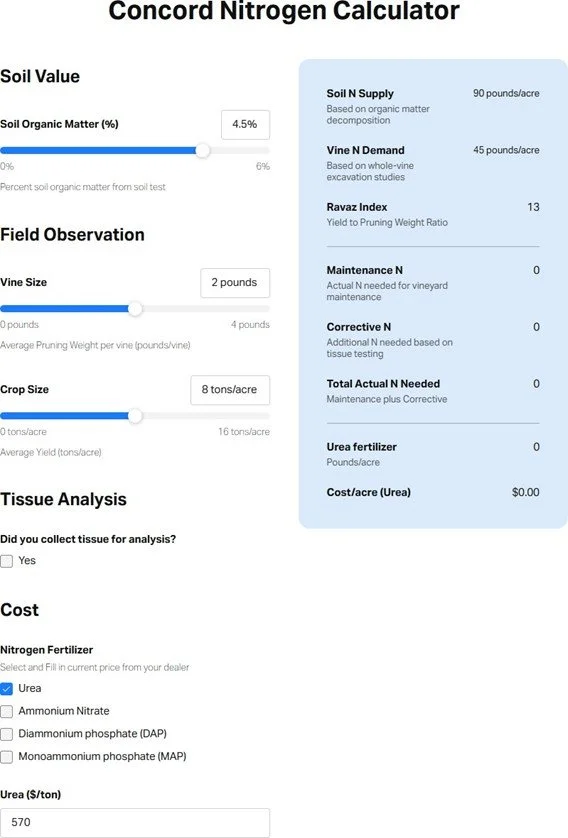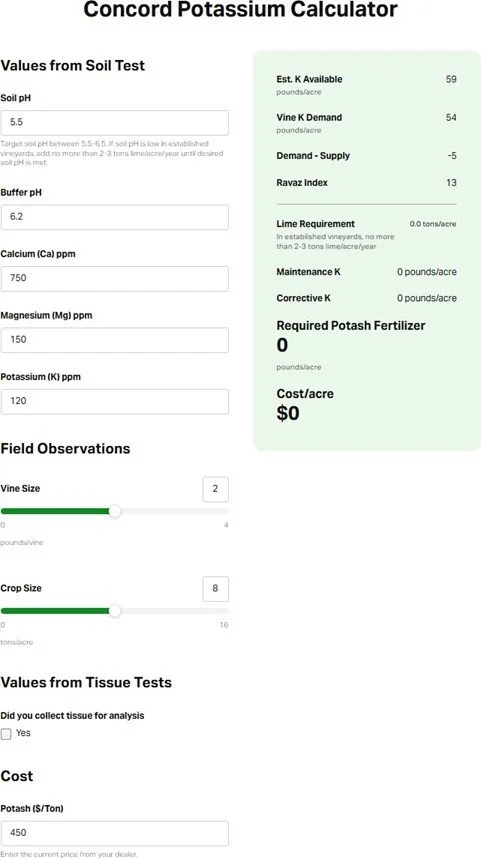In our latest episode of Between the Vines, we explored the new fertilizer calculators available on EfficientVineyard.com. These are tools that aim to revolutionize vineyard nutrient management. Rather than relying on outdated rules of thumb or isolated data points, these calculators integrate three critical components of nutrition planning: soil nutrient supply, plant uptake capacity, and crop demand. It’s an integrated tool that helps growers match fertilizer applications with the actual needs of their vineyard, avoiding both under- and over-fertilization. See Figures 1 and 2 below for a screenshot of what the calculator tools look like, or click here to access the Concord Nitrogen Calculator and click here to access the Concord Potassium Calculator.
The calculators start with the basics, or soil test results. These include organic matter percentage, pH and buffer pH, and concentrations of calcium, magnesium, and potassium. From there, it factors in vine uptake data, such as nitrogen levels in petiole or leaf tissue samples (taken at bloom or veraison), and crop demand, based on yield estimates or vine size. The calculator allows growers to input their own fertilizer product options and current pricing, giving them customized recommendations that are not only agronomically sound but also economically efficient.
One of the strengths of the tools is their ability to distinguish between maintenance and corrective fertilizer applications. Maintenance applications replace the nutrients removed through harvest or growth, while corrective applications address deficiencies identified through tissue testing. For example, the nitrogen calculator uses the organic matter content to estimate natural soil N contributions (approximately 20 lbs N per 1% organic matter), then adjusts recommendations based on tissue tests and observations of vine size or productivity. The potassium calculator, meanwhile, takes a deeper dive into soil cation balance, something especially relevant in high-yielding vineyards where magnesium can suppress potassium uptake. By prioritizing potassium when magnesium-to-potassium ratios are unbalanced, the tool helps prevent nutrient lockout and ensures fruit quality.
For growers who have adopted precision viticulture practices, this tool offers even greater value. Data from yield monitors, soil sampling grids, or vineyard sensors can be imported into the MyEV tool to generate zone-specific fertilizer recommendations. This functionality supports variable-rate applications, allowing growers to fine-tune nutrient management at a sub-block scale and optimize fertilizer use across spatially diverse vineyards.
The calculator also provides real-time comparisons of fertilizer products, showing not only the recommended application rates (in pounds per acre of actual nutrient) but also the corresponding amounts of commercial fertilizer (e.g., urea or ammonium nitrate) and associated costs. This makes it easy for growers to compare products and make informed decisions based on both performance and budget. By outputting results in familiar units and using customizable cost inputs, the calculator bridges the gap between agronomic science and practical farming.
Ultimately, this tool represents a major step forward in vineyard nutrition planning. It takes the guesswork out of fertilizer decisions by synthesizing multiple layers of data into a single, user-friendly interface. Whether you’re managing Concord or vinifera, traditional or precision blocks, the calculator helps you apply the right nutrients, in the right amounts, at the right time.
If you haven’t yet explored this resource, we encourage you to visit Efficient Vineyard Vit Blog and navigate to where the nitrogen and potassium calculators are currently hosted. Gather your soil test results, yield records, tissue data (if available), and fertilizer cost information, and start using the tool to generate both maintenance and corrective nutrient recommendations. Growers with precision data can upload zone-level inputs to create detailed, spatially variable prescriptions. And if you’re using the calculator in the field, we want to hear from you; your feedback will help refine the tool further for a broader range of varieties, rootstocks, and growing conditions.
This fertilizer calculator blends decades of vineyard nutrition knowledge with modern data tools to support more sustainable, profitable, and precise nutrient management. It’s a practical example of how technology can turn complexity into clarity, and ultimately, into improved production and better juice and wine.
Figure 1. Screenshot of the Concord Nitrogen Fertilizer Calculator on efficientvineyard.com vit blog site
Figure 2. Screenshot of the Concord Potassium Fertilizer Calculator on efficientvineyard.com vit blog site
Nitrogen Fertilizer Calculator for Concord Vineyards (Beta)
April 9, 2025
Written by Dr. Terry Bates
I am looking for feedback on this new Nitrogen fertilizer calculator for Concord vineyards. Based on input from soil tests, field observations, and tissue tests, it will calculate N rates for vineyard maintenance and corrective actions. Calculations are based on organic matter decomposition rates for Lake Erie soils, nutrient needs from both vine growth and crop yield, fertilizer uptake efficiency studies, and tissue values collected from the Hi-Res Vineyard Nutrition Project.
Enter your own information from soil and tissue tests by adjusting the sliders, and see if the calculator gives you a reasonable response for your vineyard management. If not, let me know where you think the calculator is falling short.
Disclaimer: These calculators were built based on Lake Erie Concord production for juice and wine production, where Concord is predominantly grown on its own roots and not irrigated.


